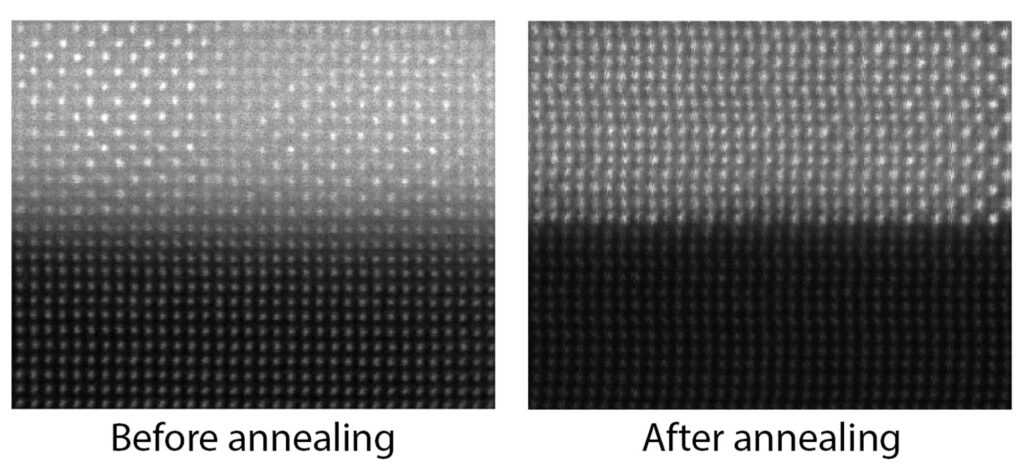Microscopy images show no discernible degradation before and after heat treating the material. Image credit: Andrej Lenert
A new heat-resistant nanophotonic material has broken records for stability at high temperatures, and shows promise for use to turn heat into electricity. Research at the University of Michigan might be used for more efficient electricity production from thermal radiation. A team of chemical and materials science engineers developed the material, which can control flow of infrared radiation and is stable up to temperatures of 2,000 degrees Fahrenheit in air. This is a nearly two-fold improvement over existing technology.
The material being developed uses destructive interference to reflect infrared energy while allowing shorter wavelengths to pass through. This can reduce heat waste in thermophotovoltaic cells. These types of cells can convert heat to electricity but can't use infrared energy.
This new nanomaterial could be used in photovoltaic solar panels as well, thermal imaging, environmental barrier coatings, camouflage from infrared surveillance and other sensing technology.
Andrej Lenert. Image courtesy the University of Michigan.
“It’s similar to the way butterfly wings use wave interference to get their color. Butterfly wings are made up of colorless materials, but those materials are structured and patterned in a way that absorbs some wavelengths of white light but reflects others, producing the appearance of color,” said Andrej Lenert, U-M assistant professor of chemical engineering and co-corresponding author of the study in Nature Photonics.
“This material does something similar with infrared energy. The challenging part has been preventing breakdown of that color-producing structure under high heat.”
The approach is a big shift away from the current state of engineered thermal emitters, which often use foams and ceramics to limit infrared emissions. These materials are stable at high temperature but have limited control over which wavelengths they let through. Nanophotonics could offer much more tunable control, but past experimental materials haven’t been stable at high temperatures, which can cause them to melt or oxidize. Many nanophotonic materials are only stable in a vacuum.
his artist’s rendering shows the material reflecting infra-red light while letting other wavelengths pass through. Image credit: Andrej Lenert
“The goal is to find materials that will maintain nice, crisp layers that reflect light in the way we want, even when things get very hot,” Lenert said. “So we looked for materials with very different crystal structures, because they tend not to want to mix.”
The team combined the experience of both traditions of chemical and materials science engineering to create a new way of producing stable nanomaterials for this purpose. The team hypothesized that a combination of rock salt and perovskite, a mineral made of calcium and titanium oxides, would be a good place to start. Collaborators at U-M and the University of Virginia ran supercomputer simulations to confirm that the combination could work.
John Heron
John Heron, co-corresponding author of the study and an assistant professor of materials science and engineering at U-M, and Matthew Webb, a doctoral student in materials science and engineering, tested the material by depositing it with pulsed laser deposition to create precise layers with smooth interfaces. They used oxides rather than conventional photonic materials to make the material more stable, because oxides can be layered more precisely and are less likely to degrade under high heat.
“In previous work, traditional materials oxidized under high heat, losing their orderly layered structure,” Heron said. “But when you start out with oxides, that degradation has essentially already taken place. That produces increased stability in the final layered structure.”
This discovery opens up a new line of potential research into other nanophotonic materials that could help create new lines of materials for commercial purposes, such as super efficient solar panels.
The research was supported by the Department of Defense, Defense Advanced Research Projects Agency, grant number HR00112190005. Study Abstract can be found here: Nanophotonic control of thermal emission under extreme conditions (DOI: 10.1038/s41565-022-01205-1)




